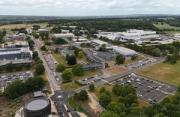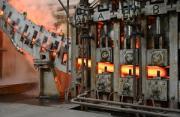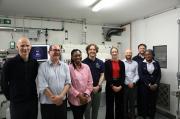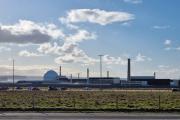2006 Seabed Survey For Particles Completed
7th September 2006
UKAEA has completed a three-month programme of offshore monitoring surveys to improve understanding of the location of irradiated fuel particles in off-shore sediments using a remotely-operated monitoring device.
The results are being compiled and a preliminary report has been sent to the Dounreay Particles Advisory Group and Scottish Environment Protection Agency.
The surveys were undertaken by a remotely-operated vehicle deployed from a surface vessel, developed and operated by Fathoms, a Caithness-based contractor, working with UKAEA. The system was shown during trials in 2005 to have a high particle detection efficiency when compared to divers who had previously undertaken manual surveys of the seabed.
Enhancements made to the system this year enabled improved estimates to be made of the particle activity and depth of burial, though without particle retrieval. The system operated wholly as intended, as demonstrated by the variety of sensor readings recorded.
The aims of the surveys were to test a computer model which predicted concentrations of particles in certain areas of the seabed, to survey in deeper water beyond the capability of divers and to find the northward edge of the main particle plume. The main plume, where the largest concentrations are found, extends a short distance westwards and a distance of 2km to the east of Dounreay.
During the 51 days of mapping, approximately 145,000 m2 of seabed was surveyed in eight targeted areas: Strathy Point, Melvich Bay, Red Point/Sandside Head, Dounreay, Crosskirk, Brims Ness, Thurso Bay and Dunnet Bay.
A total of sixteen buried particles were detected, with the higher activity particles being found in the main plume. The locations that particles were detected were: one at Red Point/Sandside, nine at the outer regions (seaward) of the main plume and six at East Brims.
Dr Joe Toole, UKAEA's particles monitoring manager, said: "The surveys did not provide any evidence of accumulations of particles off Strathy point, as had been predicted by the model, and no particles were detected off Melvich. The western-most particle was found near Red point/Sandside head close to Sandside Beach where particles of a similar activity have been found. There was some evidence of particle accumulation eastwards from the main plume, at Brims Ness, although they were not found in the region predicted by the model- they were closer inshore and at the low end of particle activity range."
"At the main plume area off Dounreay, surveys in deeper water showed a pattern of particle locations which is consistent with the edge of the plume being limited to the nearshore zone - no particles were found in any of the areas surveyed beyond the 30m water depth contour."
"Surveys in Thurso Bay and Dunnet Bay (16 km and 22 km respectively from Dounreay) did not detect any particles."
Phil Cartwright, UKAEA's Particles and Contaminated Land Department Manager, said "The data from the survey has certainly moved us forward. From the area covered - it would appear the extent of detectable particles in the marine environment is less than predicted by the computer model which is good news. We are reviewing all the data to ensure we make efficient use of this new information. We've sent a preliminary report to DPAG and SEPA and we'll ensure that all our findings are communicated to both bodies for their consideration."
"We are committed to finding the best practical environmental option for dealing with this legacy. The data gathered from these surveys is an important step forward in our understanding and will help to inform full public consultation on the options early next year."
Background Information
Particles were generated during the dismantling and preparation for reprocessing at Dounreay of spent nuclear fuel. There is evidence from the 1960s and 1970s of some of these particles entering the drainage systems at Dounreay and being discharged to sea.
Lower activity particles have been detected during routine monitoring of the beaches used by the public at Sandside and Dunnet. Other, higher activity particles have been detected on the foreshore at Dounreay and in the sediment offshore. Restrictions on fishing are in place in this area.
UKAEA is required to monitor a number of local beaches to criteria regulated by SEPA, when access is available to do so.
In March, SEPA published research into the potential health effects of particles typically found at Sandside. While there is potential for short-term visible effects to occur through skin contact, the chances of coming in to contact with a particle are extremely low.
See - http://www.sepa.org.uk/news/releases/view.asp?id=349&y=2006
UKAEA is carrying out a study to determine if there is a better option to reduce the risk from particles than the current strategy of monitoring beaches. Full public consultation on the options is scheduled for early 2007.
See Here
Related Businesses
Related Articles
UKAEA develops 3D printing for fusion components
At its recently opened Central Support Facility (CSF), UKAEA has commissioned an electron beam additive manufacturing machine that can be used to incorporate tungsten into components, alongside a selective laser manufacturing machine. Fusion can play a key role in a global low carbon energy future.Advancing Fusion Remote Maintenance: Industry Collaboration Driving Innovation
As part of the Fusion Futures (FF) programme, UKAEA's Remote Applications in Challenging Environments (RACE) has partnered with industry leaders to develop two groundbreaking technologies for remote maintenance in fusion energy engineering. Thanks to FF funding, industry has taken the lead in maturing UKAEA technology concepts—delivering real-world solutions that enhance operational autonomy and reduce maintenance burdens in extreme environments.UKAEA launches International Fellowships Scheme for fusion
UKAEA has launched the International Fellowships Scheme, an initiative to help expand the global talent pool supporting the fusion industry. The scheme is part of the UKAEA's Fusion Opportunities in Skills, Training, Education and Research (FOSTER) Programme, which aims to train, support, and empower the next generation of professionals, who will help deliver fusion power to the grid.Kyoto Fusioneering and Astral Systems join Culham fusion hub
UKAEA's Culham Campus welcomes Kyoto Fusioneering and Astral Systems as its latest tenants. Two pioneering companies, Kyoto Fusioneering and Astral Systems, have joined the growing cluster of fusion technology and AI organisations at United Kingdom Atomic Energy Authority's (UKAEA) Culham Campus.
Fusion-grade Steel Produced At Scale In UK-first
Researchers achieve 10x production cost savings for reduced activation steel. A United Kingdom Atomic Energy Authority (UKAEA) working group has successfully demonstrated the industrial scale production of fusion-grade steel.
UKAEA To Lead The Creation Of A Robotics And AI Cluster
UKAEA will lead the creation of a new £4.9m nuclear robotics and artificial intelligence cluster across Cumbria and Oxfordshire. The robotics and AI cluster was announced by UK Research and Innovation (UKRI) as one of seven new projects to kickstart economic growth and address regional needs: www.ukri.org The robotics and AI cluster will link Cumbria and Oxfordshire to accelerate the decommissioning of the UK's legacy nuclear fission facilities and keep people out of hazardous environments.
Diamonds Are Forever? World-first Carbon-14 Diamond Battery Made In Uk
The world's first carbon-14 diamond has been produced with the potential to provide power for thousands of years. Scientists and engineers from the UK Atomic Energy Authority (UKAEA) and the University of Bristol have successfully created the world's first carbon-14 diamond battery.
UKAEA Monthly Newsletter Latest Edition
Find out what has been happening at UKAEA in our monthly newsletter. Read about our recent activities and upcoming events.
UKAEA Newsletter - Edition 11 Published Today
Find out what has been happening at UKAEA in our monthly newsletter. Read about our recent activities and upcoming events.
Corwm Visits Dounreay Nuclear Site
Members were given an overview of the scale of the problem and challenges faced in the decommissioning of the site. In the last week of March 2024, several members of CoRWM led by the Chair, Sir Nigel Thrift, made the long journey up to the North of Scotland to visit the Dounreay nuclear site, now managed by Nuclear Restoration Services.
